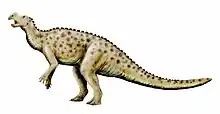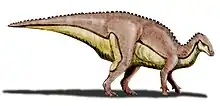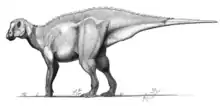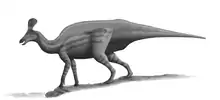| Aquilarhinus Temporal range: Late Cretaceous, | |
|---|---|
 | |
| Restoration | |
| Scientific classification | |
| Domain: | Eukaryota |
| Kingdom: | Animalia |
| Phylum: | Chordata |
| Clade: | Dinosauria |
| Clade: | †Ornithischia |
| Clade: | †Ornithopoda |
| Family: | †Hadrosauridae |
| Genus: | †Aquilarhinus Prieto-Márquez, Wagner and Lehman, 2019 |
| Species: | †A. palimentus |
| Binomial name | |
| †Aquilarhinus palimentus Prieto-Márquez, Wagner and Lehman, 2019 | |
Aquilarhinus (meaning "eagle snout" after the unusual beak morphology) is a genus of hadrosaurid ornithopod dinosaur from the Aguja Formation from Texas in the United States. The type and only species is Aquilarhinus palimentus. Due to its unusual dentary, it has been inferred to have had shovel-like beak morphology, different from the beaks of other hadrosaurs. It was originally classified as a Kritosaurus sp. before being reclassified as a new genus in 2019.
Discovery
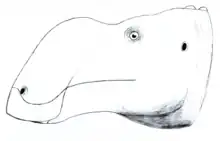
The holotype fossil (TMM 42452-1) of Aquilarhinus was discovered in the Lower Shale of the Aguja Formation in Big Bend National Park, Texas. Most parts of the specimen were collected in 1983, but additional elements were collected during continued excavations in 1999.[1] The specimen was first described in 2001 as a new species of Kritosaurus,[2][3] because aside from its rostrum it was morphologically very similar to Kritosaurus notabilis.[4] The differences in the rostrum were interpreted as being a functional adaptation for "shoveling out and scooping up vegetation."[5] Despite the fossil's identification within the genus Kritosaurus, its phylogenetic position remained unclear.[4]
In 2019, the species was reclassified into a new genus and given its binomial name Aquilarhinus palimentus. Aquilarhinus comes from the Latin 'aquila' meaning 'eagle' and the Greek 'rhinus' meaning 'nose', referring to the unique shape of the rostrum, and palimentus comes from the Latin words 'pala', meaning shovel, and 'mentus', meaning chin, referring the shape of the predentary and its resemblance to a spade or shovel.[6]
See also
References
Notes
- ↑ Prieto-Márquez, Wagner & Lehman 2020, p. 463-464.
- ↑ Prieto-Márquez, Wagner & Lehman 2020, p. 462.
- ↑ Wagner 2001, p. 140.
- 1 2 Wagner 2001, p. 233.
- ↑ Wagner 2001, p. 236.
- ↑ Prieto-Márquez, Wagner & Lehman 2020, p. 463.
Sources
- Prieto-Márquez, Albert; Wagner, Jonathan R.; Lehman, Thomas (2020). "An unusual 'shovel-billed' dinosaur with trophic specializations from the early Campanian of Trans-Pecos Texas, and the ancestral hadrosaurian crest". Journal of Systematic Palaeontology. 18 (6): 461–498. doi:10.1080/14772019.2019.1625078. S2CID 202018197.
- Wagner, Jonathan R. (2001). The hadrosaurian dinosaurs (Ornithischia: Hadrosauria) of Big Bend National Park, Brewster County, Texas, with implications for Late Cretaceous paleozoogeography (MSc).

